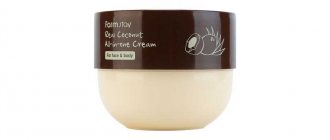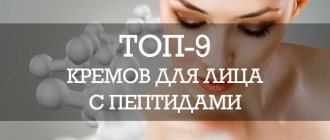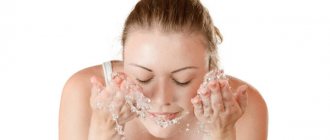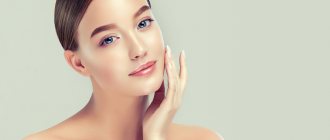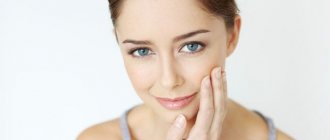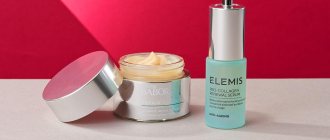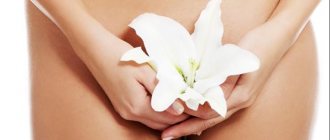Collagen is one of the proteins in our skin, it is also called the “protein of youth”. This is because it, in tandem with elastin, provides firmness and elasticity to the skin, acting as a “springy mattress”.
After 45 years, the body reduces collagen production to almost zero. The rest of a person's life lives on supplies made before this age.
There are more than 20 types of collagen, but types I and III are the most important for good skin condition.
Who produces collagen and who destroys it?
Collagen in the skin is synthesized by special cells - fibroblasts , but it is destroyed due to the action of enzymes. These two processes are constant, but with age (after 35 years) destruction begins to prevail over synthesis: elastic fibers are destroyed, become hard and brittle, damaged, fragmented collagen accumulates in the skin.
This leads to the skin losing strength and elasticity, becoming flabby, drying out due to the loss of protein’s ability to retain moisture, and wrinkles forming.
Young skin (up to 30 years) synthesizes about 6 kg of collagen per year; after 35 years, this figure drops to 3 kg, and then continues to decrease year by year.
How to get collagen back?
The first thing you hear is advice on optimizing your diet. It is believed that the diet needs to be varied:
- vitamins C, A, D;
- peptides (collagen building material);
- retinoids (stimulants of fibroblasts).
But artificial collagen is also often mentioned: it can be of animal origin (allergenic and is not used), plant origin (can also cause allergies and has virtually nothing in common with the original protein) and marine origin.
Artificial collagen in creams, masks and dietary supplements
The problem with artificial collagen for external use ( in creams, gels, masks ) is that the large protein molecule does not penetrate the stratum corneum of the skin, but only temporarily fills unevenness and microcracks on its surface.
The apparent effectiveness of the drugs is explained by the moisturizing effect. It occurs as a result of the formation of a film on the surface of the skin, which makes it difficult for the evaporation of water from the upper layers of the epidermis.
Food supplements are also widely advertised , but these drugs have virtually no effect on the condition of the skin, since in its finished form the protein is difficult to absorb from the digestive tract.
Type I and III collagen, neither in the form of pills nor in the form of creams, does not reach the deep layers of the dermis. How to restore elasticity and youth to the skin?
It is important to understand that “ready-made” collagen will not greatly help the skin gain elasticity and density, because the substance of the native “human” type has not yet been synthesized .
Creams and dietary supplements use “marine” collagen , which the body still needs to integrate into the structure of the skin; this process occurs due to the destruction of the protein itself, separation into constituent amino acids and hydroxyprolines (don’t remember these words!). What is the point of injecting “ready-made” collagen into the skin for it to break down there?
The process of absorption of substances
As noted earlier, glucosamine and chondroitin are found in a bound state in many foods and are poorly absorbed. The chondroitin sulfate molecule is a hundred times larger than the glucosamine molecule, and its bioavailability is about 15-20%. Glucosamine contains a glucose core, which, as a conductor, increases digestibility by up to 41%.
Therefore, to strengthen your joints, you first need to start eating right.
You should not self-medicate if you have complaints:
- crunch;
- pain during movements;
- morning stiffness;
- restriction of movements;
- edema;
- hyperemia of the skin over the joints.
In this case, only a specialist will individually select therapy aimed at reducing inflammation and pain, restoring the cartilage framework and, consequently, motor function.
Effective skin rejuvenation can be achieved in two ways:
- delivery to the dermis of substances that stimulate the natural production of collagen, preferably not only types I and III (types IV, V, and VII are also important, for example);
- stimulation of fibroblasts so that they don’t become lazy after 30 years and continue to produce collagen as they did at 18.
Building material can be delivered to the skin in two ways: by adding the necessary elements to the diet or by performing an injection procedure (introducing the necessary elements using injections). The first way takes longer and has a cumulative effect, the results of the second can be assessed almost immediately after the procedure.
In order for your skin to be healthy and youthful, your diet must include:
- vitamin C in sufficient quantities;
- copper (cod liver, spinach, cocoa powder, beef liver);
- pyridoxine (vitamin B6): pistachios, garlic, beans;
- zinc (oysters, wheat bran, eel, sesame);
- sulfur-containing compounds - sulfur, glutamine (rabbit, chicken breast, turkey, egg powder);
- selenium (pistachios, walnuts, beans and lentils, broccoli, tuna);
- silicon (unpolished rice, oats, millet, barley).
Let us separately note those compounds and substances that stimulate the work of fibroblasts :
- vitamin A (fish oil, beef liver, carrots);
- vitamin D (fish oil, cod liver, fatty fish, seafood);
- peptides.
If you manage to create a diet of all the listed products with minor deviations, after 6-9 months your skin condition will noticeably improve!
Healthy foods
It is better to prevent a disease than to treat it. By consuming healthy foods, we give the body all the necessary vitamins and microelements, thanks to which the body is restored at the cellular level. To prevent diseases of the musculoskeletal system, you first need to adjust your diet by consuming foods for joints.
What products are needed for joints and cartilage?
- red fish;
- greenery;
- animal cartilage;
- white meat;
- milk;
- hard cheeses;
- yogurt;
- low-fat kefir;
- gelatin;
- dried fruits: prunes, dried apricots, dates, raisins;
- eggs;
- cereals;
- mushrooms;
- corn.
Red fish contains a lot of phosphorus, calcium, and healthy fats, which improve the composition of synovial fluid and strengthen cartilage. Greens are rich in magnesium, which strengthens nerves in joints. Animal fats are well absorbed because... they are similar to human cartilage.
White meat contains iron to nourish joints. Dairy products supply calcium for arthrosis of the joints. Gelatin contains a lot of chondroitin and glucosamine. Foods rich in selenium and sulfur are involved in protein synthesis, so selenium-containing foods should be on the table every day - legumes, eggs, cabbage, apples, onions, radishes.
Chondroitin and gelatin are destroyed during heat treatment, so it is recommended to cook at low temperatures, preferring boiling or stewing.
Let us note which products contain glucosamine and chondroitin:
- Plant glucosamine is obtained from corn.
- Animal glucosamine is produced from the shell of crustaceans.
- Chondroitin of animal origin is extracted from the trachea of cattle and the cartilage of red fish: salmon, sturgeon.
Chondroitin and glucosamine obtained by such methods have high bioavailability and are used in the manufacture of chondroprotectors.
Differences between collagen types I and III
We found out that all kinds of dietary supplements with collagen are useless for the skin. Only natural products are effective, although you should not refuse the help of cosmetologists.
So, how can our specialists help?
To begin with, we note that cosmetologists see significant differences between type I collagen and type III collagen :
- collagen type I (fibrous) predominates in the skin composition (about 60%), has an uneven and dense structure;
- Type III collagen (reticular) is the most desirable because it is responsible for the youth of the skin, its fibers are smooth, slender, with excellent elasticity.
When damaged, type III protein turns into type I. For example, our scars and scars are made entirely of type I collagen.
Why is it needed?
Collagen supports the skin from the inside, like springs support a mattress. He is responsible for its strength and elasticity. That is, the skin is not damaged when stretched and does not change its structure precisely thanks to collagen. It seems to “spring”: it stretches and returns to its original shape.
This fixing role of collagen is also indicated by its name. From Greek kola – “glue”, gen – “to create”.
Collagen depends on:
- skin elasticity,
- tightened oval,
- smooth relief without wrinkles,
- shape and proportions of the face.
But what exactly happens to collagen when age-related changes begin? Most of us don't know the answer to this question. Instead, they believe in dangerous myths that are spread by cosmetologists.
Stimulating collagen production
The cosmetologist’s task is to stimulate the formation of elastic fibers of type III, although the older the patient, the more difficult it is to “awaken” and “stimulate” fibroblasts. There are studies proving the impossibility of synthesizing “youth collagen” in old age after 65 years. This means that you need to stock up on “young” collagen in advance!
- Procedure mesotherapy.A series of injections with a thin needle or cannula, during which the necessary substances for collagen synthesis are introduced into the skin, as well as peptides with amino acids to irritate and stimulate fibroblasts. The effect is the same as from 3-4 months of an enhanced “collagen-stimulating” diet!
The entire face requires at least 2 ml of the drug (preferably 3-4)! This is the case when the desire to save money can lead to lack of results and disappointment.Cannulas can be used to perform papular mesotherapy (so-called bioreparation), but the injection technique is better and more effective.
- Mesoradiesse procedure (RD or RHD) is a procedure for strengthening (bio-reinforcement) of the skin with Radiesse . A dense white preparation is diluted with saline and injected into the middle layers of the skin in the form of a “lattice”.
What's the point? Radiesse contains calcium hydroxyapatite (this substance is part of our skeletal system, that is, not foreign to the body). Radiesse microspheres introduced into the skin cause skin macrophages to activate (as a response to external influences). In turn, macrophages, which actively destroy calcium hydroxyapatite, stimulate fibroblasts to synthesize new collagen, and studies have confirmed the presence of newly synthesized type III collagen at the sites of drug administration. - The radiofrequency lifting procedure ( RF-lifting ) uses the properties of protein to “shrink” under the influence of temperature and other influences (remember what happens when you cut meat in a frying pan - it decreases in size).
After exposure of the skin to RF radiation, the chains of collagen and elastin inside the skin are compressed and rolled up, providing a lifting effect. During irradiation, type III collagen is damaged and over time “transforms” into the fibrous type. The RF lifting procedure does not stimulate the production of new collagen: during temperature exposure, only a change in the type of collagen in the dermis occurs, and not a very desirable one. - Plasma therapy is the introduction of the patient’s enriched plasma into the deep layers of the skin. It allows you to start the process of neocollagenesis due to the same stimulation of fibroblasts, however, for better results, it is recommended to combine the procedure with mesotherapy.
How to influence the synthesis of connective tissue to increase collagen levels?
This question interests users. But only people who have become victims of cosmetologists’ propaganda can put it this way. As we have already found out, collagen levels DO NOT NEED to be increased. This will only increase the collagen “clog.”
On the contrary, our task is to cleanse the extracellular matrix of collagen fragments and cross-links. “Break through” the thick and impenetrable web that they form. Replace the incorrect collagen, which prevents moisture and nutrients from reaching the cells, with the correct one, with intact, strong, separate fibers.
Daily routine, sleep and hormones
Collagen synthesis is impossible without the support of hormones. Thus, the process of neocollagenesis is influenced by sex hormones, the receptors for which are found in fibroblasts. The production of “youth protein” depends on the percentage of estrogen in the body, so in menopausal women, when the amount of female sex hormones sharply decreases, negative changes in the skin also occur. But the main hormone responsible for collagen synthesis is somatotropin . It is notable for its daily rhythms of secretion. The highest and most predictable peak in growth hormone production occurs at night, usually 2 hours after falling asleep. However, a number of studies show reduced rates of hormone secretion in people who go to bed after 1 am (the so-called “night owls”). Therefore, it is generally accepted that the most favorable hours for restoring the beauty of the skin are the interval between 11 pm and 1 am.
Why do you need this knowledge?
After the Radiesse biostimulation procedure or mesotherapy, at least for 2-3 months after it, try to go to bed no later than 21-22 o'clock at night. In combination with a “collagen-stimulating diet,” this approach will allow you to achieve impressive results and maintain the rejuvenation effect for a long time.
Daily norm
The required daily amount of collagen depends on various factors: a person’s lifestyle, his age. People who do not experience serious physical activity should receive about five to seven grams of this substance per day.
But the recommended daily dose for athletes or people involved in heavy physical labor increases to ten grams.
To compensate for the lack of collagen, there are various medications and dietary supplements. And the best way to prevent its deficiency is to eat foods that promote the production of this protein in our body.
Zinc
Zinc is the only metal present in the non-protein part of enzymes of each class, and zinc cannot be replaced by any other metal. Despite the low concentration of zinc in the blood, stable bonds with macromolecules make it available to all tissues of the body, which further allows it to satisfy the needs of proteins and enzymes that perform various biological functions [28].
The prevalence of zinc deficiency in the world is no less significant than that of iron and vitamin C, and amounts to up to 60% [29].
Zinc is absolutely necessary for the transport of oxygen and carbon dioxide by erythrocytes, and most of the zinc in the blood is contained in erythrocytes as part of zinc metalloenzymes - carbonic anhydrase. Carbonic anhydrases catalyze the conversion of carbon dioxide into carbonic acid (carbonic acid is involved in maintaining blood pH in the physiological range (7.25–7.35). In the capillaries of the lungs, these processes go in the opposite direction: carbonic acid breaks down into carbon dioxide and water, and carbon dioxide the gas is removed outside [18].
Without normal respiration, not a single cell is able to carry out its functions.
Contraindications
Collagen supplements are considered safe for most people and have virtually no contraindications. However, some of them are produced using common food allergens - eggs, cow's milk, fish, seafood, nuts, wheat, soy. Therefore, before taking such drugs, you should always carefully study their composition. If you have an individual intolerance to any of the components of a food supplement, you will have to stop taking it and find a safer analogue.
Collagen should also be taken with caution by people who suffer from kidney failure and liver diseases. An excess of protein in the diet significantly increases the load on these organs. Pregnant and lactating women can use collagen supplements only under strict medical supervision.
In addition, in some cases, collagen supplements can leave an unpleasant taste in the mouth, cause heartburn and a feeling of heaviness.
Vitamin D
The prevalence of vitamin D deficiency in the Russian population is more than 90% (50–60% in the world) [19]. This vitamin stimulates an increase in the synthesis of secreted proteins TGF-β (regulate the division and differentiation of various types of cells, including fibroblasts and keratinocytes) and their binding to receptors on the cell membrane. Therefore, when it is deficient, the activity of the TGF-β signaling cascades is disrupted, which impairs skin healing after any injury (including cosmetic manipulations). For example, during thermolifting, part of the collagen fibers of the dermis contracts and decreases in volume. This leads to an increase in the granularity of the basal layer and, with a sufficient amount of vitamin D, creates favorable conditions for the effect of its active forms on the expression of TGF-β1, which promotes the renewal of connective tissue [11].
